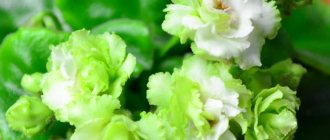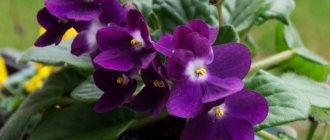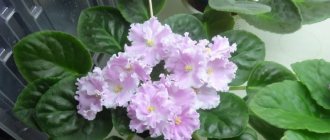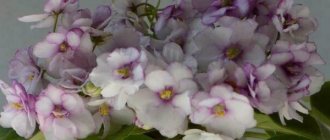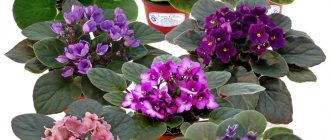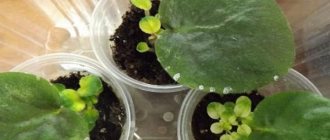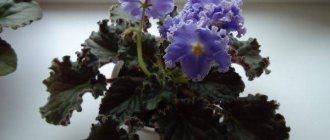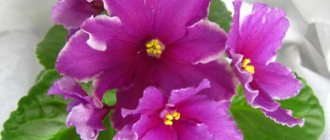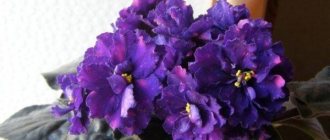Indoor plants help create coziness in the home and violets will be irreplaceable in this case. Small neat bushes with colorful flowers look very cute and touching. The richness of the choice of varieties is amazing, but the “Maria” violet is guaranteed to attract your attention thanks to its voluminous double inflorescences, slightly reminiscent of a star shape, and unusual color. Despite its somewhat exotic appearance, this violet is quite unpretentious. How this plant appeared and how to care for it is what we will talk about in this article.
Violet cuttings
This method is most often used at home. In this case, rooting occurs almost 100%. But when growing “Virgin Mary” violets, you should remember that this variety is highly athletic. Therefore, no one can guarantee that a flower grown from a leaf will have the same flowering characteristics as the mother plant.
- Carefully cut a strong leaf from a healthy mother plant at an angle.
- The leaves are rooted both in water and in soil or a peat tablet.
- The cut leaf should be rooted immediately.
- You can create greenhouse conditions for it using a glass.
- After some time, babies will appear on the cuttings. At this stage, you should carefully remove the leaf.
- Under favorable conditions, the violet will bloom in 1 year.
Transplant rules, rejuvenation
Saintpaulias are replanted every year or once every two years. Ideally, transshipment should be done annually. A violet living in the same soil for more than two years does not produce:
- Abundant flowering;
- And beautiful foliage.
The easiest time to transplant violets is in March. The diameter of the pot remains the same. The main task of replanting is to stimulate the growth of young roots, which will provide strength and nutrition for strong leaves and peduncles.
Transplantation is an excellent reason to rejuvenate the plant; it is carried out according to the following algorithm:
- It is better not to water the violet before transplanting. Dried soil will not damage the roots when transplanting;
- Carefully remove the roots, freeing them from most of the old substrate;
- Remove old, diseased leaves and roots;
- Place the violet in fresh soil, covering it with soil up to the leaves;
- After a day, you can water the flower and add more soil.
ATTENTION! It takes about three weeks for Saintpaulia to settle into new soil.
Properties
Name
- Original: Marquise
- Transcription:
- Translation:
Registration
- Selection: T. Dadoyan
- Year: 2010
Socket
- Socket type: standard
Flower
- Flower size, up to: 5.5 cm
- Flower shape: star
- Terry: terry
- Main Color: Hot Pink
- Color type: plain
- Border: double
- Other features:
Foliage
- foliage color: dark green
- foliage type: simple
- foliage shape: pointed, heart-shaped; quilted
- reverse side of sheet: red
- leaf edge: jagged edge
- variegation
Characteristic
Note that calling this plant a violet is not entirely correct from a terminological point of view. The variety is Saintpaulia, which flower growers call “Uzambara violet”. Therefore, shortening this phrase, we will allow ourselves to designate the amazing indoor plant “Maria” as a violet.
It was presented to lovers of indoor plants by Tatyana Dadoyan. For several years, the woman breeder created flowers for herself, and then showed her amazing “creations” to other people. Dadoyan devoted about 5 years to her hobby and presented more than 10 varieties of her violets to the public. They are distinguished by their amazing shape and stunning shades of inflorescences. The female breeder continues to work on the discovery of new species of Uzambara violets.
It is worth taking a closer look at the description of the “Maria” variety. This is a luxurious indoor plant with delicate original flowers and a rosette of rich green shade. It is necessary to note the following characteristic features:
- the “Maria” variety is famous for its large, double flowers, which bloom for a long time and resemble small roses or “stars”;
- light petals with a pinkish tint (the edges are bright crimson) and a thick green “ruffle”;
- inflorescence size – 4–6 cm;
- the brightness of colors directly depends on the conditions of detention (temperature, availability of light and fresh air);
- wavy green leaves; the rosette is rather loose and has long petioles;
- when growing the variety on shelves, the leaves will rise; a violet, which is “kept” in a flowerpot on the window, will lower the foliage down - this feature completely depends on the presence of light;
- the variety cannot be classified as early ripening; "Maria" grows quite slowly;
- This violet is unpretentious and produces a lot of “babies”.
Another amazing variety of indoor violets is called “LE Maria Mirabella”. Its creator is breeder Elena Lebetskaya.
This Saintpaulia is distinguished by incredible bright pink double flowers - “stars” with a speckled border (corrugated). The inflorescences are characterized by gradual opening, and the spots on the tips of the petals darken day by day.
I have been growing violets for over 15 years. During this time, more than one hundred varieties have been in my collection. I fell in love with some varieties and they have not left my collection for many years. And some varieties were supplanted by more promising relatives. In general, like any collector, I am in a constant search for the unattainable - the “ideal violet”!!! What is this ideal? Everyone decides for themselves, since everyone has different tastes and preferences!
Regular participation in exhibitions allowed me to form a collection of violets from “show varieties”. After all, not all varieties can become winners at exhibitions. These should be abundantly flowering and unpretentious varieties that form neat rosettes that delight the eye with their flowering and attractive appearance. Well, some exotics do not leave me indifferent.
My personal opinion is that a violet should please its owner, and not force him to dance around it with a tambourine in the hope that it will finally please him with at least one flower. While growing flowers, you have probably come across the fact that each variety has its own specific character. Some varieties - “hard workers” - can grow by leaps and bounds, while others act as “mimosa” - a kind of sissy saboteur, to whom it is sometimes difficult to find an approach. “Why sissy saboteurs,” you ask? A saboteur is because, falling into the hands of an inexperienced novice florist, with their whims they can undermine the authority of their more flexible brothers! Therefore, I have a short conversation with stubborn mimosa slow-witted people - in the compost...
After all, there are so many other beautiful and accommodating varieties that need a place in the sun, or rather, under the lamp!!
Note! All plants are grown by me at home on specially equipped shelves with lighting. Artificial lighting allows you to keep a large number of plants even in the darkest place of the house and allows violets to bloom all year round. Since my plants are not greenhouse, they are well adapted to indoor conditions.
Since my plants are not greenhouse plants, they are well adapted to indoor conditions.
Online store “PoTsvety”
Our store presents indoor flowers of different types and varieties from a private collection. From us you can purchase both adult flowering plants and planting material: leaf cuttings, children, tubers, etc. All plants are adapted to indoor conditions. Twice a year the entire collection undergoes comprehensive preventative pest control. The collection has been collected since 2010 and is constantly updated with new exclusive varieties of beautifully flowering indoor plants.
You can place an order in any way convenient for you: directly through the store by creating a basket; by phone 8-906-854-07-75 (WhatsApp, Viber); via email (in a message or text of the letter, write the names of plant varieties and specify in what form you would like to purchase them (baby, cuttings, tuber, etc.)
An invoice for payment is issued after the order has been processed and some details have been agreed upon with you.
After receiving your order using any of the above methods, we will contact you by phone or email.
The terms of delivery of the order are negotiated separately; you can express all your wishes in the comments to the order.
Reproduction
To grow “Maria” yourself, you do not need to have special skills and knowledge. Everything is quite simple and easy. There are such methods of reproduction as:
- cuttings;
- propagation by seeds and peduncles;
- stepsoning.
For “home” propagation, it is better to use methods 1 and 3. When cutting violets, rapid rooting occurs. This method involves the following steps:
- cut off a large healthy leaf on the “mother” plant;
- we root it in a small container with water or in loose soil (at a depth of no more than 2 cm);
- We are waiting for the “babies” to appear on the sheet (the process lasts up to 2 months);
- When roots form (1–2 cm), plant the plant in the ground.
Another effective method of propagating violets is pinching. It looks like this:
- we make a choice in favor of a healthy “mother” plant;
- we find the stepson (it should have no more than 3 leaves) and cut it off using a sharply sharpened knife;
- We act carefully, trying not to touch the main outlet of “Maria”;
- we root the stepson; a peat tablet or potting soil will do;
- we create greenhouse conditions for it for 1–1.5 months;
- As soon as rooting occurs, we plant the plant in the ground.
A review of the violet “LE Maria Mirabella” awaits you in the video below.
https://fialki.in.ua/ru/marina/?limit=allhttps://fialki.su/node/4571https://www.violets.lact.ru/e/2979354-le-marinahttps://stroy -podskazka.ru/senpolii/sorta/mariya/
Violet Maria (T. Dadoyan)
Tender violet Maria (T. Dadoyan).
The species that loves mountainous Africa, “violet” (or Saintpaulia), contains both annual and perennial plants . It belongs to the Gesneriaceae family. The flower has enjoyed enormous unabating popularity all over the world for many decades. The species is valuable not only for the diverse beauty of its varieties, but also for its rather unpretentious maintenance requirements.
The main thing is to know the basics of care , and sincerely admire your specimen - this way the plant will try its best to please the owner with exuberant flowering.
History of origin
Experienced and widely known breeder Tatyana Lvovna Dadoyan obtained Maria by sporting from the Fairy variety . The fairy, a double miracle, covered with large white flowers with a deep pink tint, became a good parent, passing on to Mary all her varietal beauty. This is how a luxurious fixed sport turned out.
The variety belongs to Tatyana Dadoyan.
Quote (T.L. Dadoyan): “The flowers are large, up to 7 cm. Densely double, they remain in the form of “heads of cabbage” for a long time during dissolution. The petals are white with a slight pinkish tint, along the edge there is a crimson border with a dusting and a thick green ruffle. The leaf is medium green, wavy.”
Maria has the same one as the Fairy:
- Fluffy corrugated edge frill of petals;
- And the delightful shape of the flowers, reminiscent of a delicate rose enclosed in a head of cabbage.
Distinctive features
- Densely double large flowers (5 – 7 cm);
- The petals are white with a pinkish tint, the border is from fuchse to bright crimson, ending in a light green thick ruffle;
- The brightness of the color is determined by temperature and lighting;
- Flowering is exceptionally long;
- The leaves are standard, lush green, with a light wavy edge and curly at the rosette;
- Loose, voluminous rosette;
- The petioles are long.
The plant develops slowly; before flowering it needs to become sufficiently strong , but this feature is more than compensated for by its unpretentiousness and abundance of children.
Advice! A real varietal plant will “overgrow” with a light green ruffle in any case, but to be sure, you should wait for at least the third flowering.
Forum of flower growers Frau Flora
About growing indoor and garden plants; discussion of species, varieties, diseases, pests.
- Unanswered topics
- Active topics
- Search
- About Us
- ConferenceIndoor floricultureSaintpauliaSaintpaulia of other Russian breeders
- Search
Maria (T. Dadoyan)
Moderator: Floriana
Maria (T. Dadoyan)
Post by Elena M. » 02 Dec 2013, 23:57
Saintpaulia Maria. Breeder T. Dadoyan.
While at the exhibition I saw a copy of the Saintpaulia variety Maria. The owner of the plant is Lyudmila Lysenko. She told me that this is exactly the kind of Mary she should be. The photo shows the second generation of the variety. It was received from an outlet that Tatyana Lvovna Dadoyan personally approved and named Maria. The second generation fully conveyed the varietal characteristics of the source material. After asking Luda’s permission, I decided to show this copy on the forum. Many will now have the opportunity to distinguish the real Maria from other “pseudo Marias” that have bred as a result of various sports from the Fairy and are illegally called Maria.
Re: Maria (T. Dadoyan)
Post by Din-don » 04 Dec 2013, 09:29
Re: Maria (T. Dadoyan)
Post by Yalo » Dec 20, 2013 07:47 pm
Dear Tatyana Lvovna. (if you came here) I have one more big request for you. I hope that collectors will also support me in this. Please give a description of the “Maria” variety, which is a sport from your “Fairy” variety. Even the two plants exhibited by Lyuda Lysenko, whose sport was given the status of the “Maria” variety, and one of which was a descendant of that very first rosette, are quite different from each other. What can we say about plants grown in other conditions? Even warm-cold will make a huge difference in the brightness of the color (white-colored). The children grown from varietal cuttings also had (for me) a completely different appearance.
When propagated, the Fairy variety produces a lot of curly hair (from practice, approximately 50x50). Often such sports are written as Maria. Only your description will allow you not to rack your brains every time about what the collector brought to the exhibition.
Re: Maria (T. Dadoyan)
Post by Tatyana L. » Dec 20, 2013, 07:49 pm
Dear Olga Viktorovna, first about the Fairy. How was the Fairy variety created? You know, I started - our entire group “Moscow Violet” continued. Thank you and all the girls. Whether we succeeded or failed to do something, I don’t know, if it’s 50/50, as you say, probably not entirely.
As for Maria, once at an exhibition at Lyuda Lysenko’s I saw sports from the Fairy. Lyuda asked permission to check it for grade. I liked the flower and agreed, asking that if she succeeds in checking this specimen for repetition of varietal characteristics, name the violet Maria. She worked with this sport, she knows better, and ask her questions about the description. And as you know, I haven’t been working with violets for two years now. Unfortunately. I would like to thank you, Olga Viktorovna, and all our girls for your kind and warm attitude towards me. Thank you.
Re: Maria (T. Dadoyan)
Post by Elena M. » Dec 20, 2013, 10:26 pm
Re: Maria (T. Dadoyan)
This is what happened to me
Re: Maria (T. Dadoyan)
Post by Elena M. » 24 Feb 2014, 15:20
Re: Maria (T. Dadoyan)
Post by Olga55 » 25 Feb 2014, 08:49
Re: Maria (T. Dadoyan)
Post by LenaU » 04 Mar 2014, 14:05
Re: Maria (T. Dadoyan)
Post by TanRa » 02 Feb 2015, 17:42
What do I have? Did you buy a sheet like Maria? Some doubts torment me, this is the first flowering.
Re: Maria (T. Dadoyan)
Post by Olga55 » 03 Feb 2015, 07:18
Re: Maria (T. Dadoyan)
Post by Elena M. » 03 Feb 2015, 21:46
Re: Maria (T. Dadoyan)
Post by TanRa » June 27, 2015, 6:22 pm
Has my Maria bloomed again (either a variety or a sport)?
Maria (T. Dadoyan)
Post by Gottfried Julia » July 27, 2015, 12:25
I tried to have a Fairy several times, but the children grew up exclusively like Maria. Which I was also incredibly happy about, the flowers were luxurious. Very large, voluminous. Flowering is abundant.
The last flower stalks have blossomed with a rich green ruffle.
Maria (T. Dadoyan)
Post by MAK » 11 Nov 2016, 20:12
Girls, this is how Fairy's sportswear grew up. I showed the first flowering in that topic. Now it's the second one. I grew a large rosette on matte watering. The leaves are curly. And these are the pom-poms. What should Mary be like? But in my conditions there was no green border yet
Maria (T. Dadoyan)
Post by Florian » 11 Nov 2016, 20:41
Maria (T. Dadoyan)
Post by MAK » 12 Nov 2016, 02:00
Maria (T. Dadoyan)
Posted by Yalo » Nov 12, 2016 11:28 am
MAK, I am posting a photo of the same sport from the Fairy that Lyudmila Lysenko got, Tatyana Lvovna really liked and to which she gave the name 'Maria'. Both you and Gottfried Julia simply have sports from Fairy or from Maria, depending on which variety the cuttings were taken from for propagation.
Growing
As we have already said, this plant is quite unpretentious, but you should pay attention to the following tips before planting it:
- the pot should be of medium size, since the plant will dynamically grow its root system, so a container that is too small will lead to the death of the violet;
- It is better to place “Maria” on the western or “eastern side; the lighting should completely “envelop” the plant, so do not forget to turn it periodically;
- It’s a good idea to purchase artificial lighting (fluorescent lamps are suitable);
- the optimal air temperature for violets is up to 22 degrees above zero;
- this variety does not welcome constant drafts and direct sunlight;
- use a special soil for Saintpaulia or a mixture (it contains leaf, coniferous and peat soils with the addition of baking powder).
Caring for a plant at home
Usambara violets are often found in:
- Apartments;
- And offices.
Caring for them is not difficult, you just need attention and an individual approach to each plant. For violets to bloom profusely and delight them with beautiful foliage, provide them with:
For violets to bloom profusely and delight them with beautiful foliage, provide them with:
- Optimal care;
- And good conditions.
Proper watering and fertilizing
Water the violets when the top layer of the substrate has dried. Remember that plants of different ages, sizes, living in different soils need watering at different intervals.
Therefore, an individual approach is important. By watering all the Saintpaulias in the collection together, you can overwater some and dry out others.
We use settled water for irrigation at room temperature.
ADVICE! It is convenient to water violets with a watering can with a long thin spout or a large syringe. A stream of water is directed to the edge of the pot, to the border with the substrate, making sure that the drops do not fall on the petioles and the growing point.
Feeding is carried out based on the following rules:
- Saintpaulias need nitrogen only during the period of active growth, that is, from transplanting to flowering;
- Potassium and phosphorus will ensure long-lasting, abundant flowering;
- Microelements will help withstand unfavorable conditions;
- When choosing between fertilizing and replanting, choose replanting.
There are many forms of fertilizers available on the market:
- Granules;
- Sticks;
- Powders;
- Liquids.
Experienced gardeners prefer to use liquid fertilizers containing chelated forms of nutrients.
You must remember to feed violets.
Lighting and temperature
SM-Polka prefers bright, diffused sunlight. If it is not possible to place pots on an east or west window, use a phytolamp. In any case, the daylight hours for these flowers should be at least 10 hours.
ATTENTION! With a lack of light, the petioles become elongated and the rosette becomes spreading.
Air humidity
A resident of river banks and waterfall terraces, Saintpaulia is demanding of air and substrate humidity. These flowers are most comfortable at an air humidity of 50-60%. An adult healthy violet, with regular watering and good lighting, can bloom at 40%.
What kind of soil does he prefer?
High-moor peat must be included in the soil composition for Saintpaulias. Based on the experience of flower growers, purchased soil is rarely suitable for them.
The soil mixture in which the violet will grow must meet the following requirements:
- Good moisture absorption;
- Be light, breathable;
- Contain macro and microelements, without excess nitrogen;
- pH from 5.5 to 6.5;
- Free from pests and diseases.
When composing a soil mixture for violets, you can follow two approaches:
- A simple mixture of high-moor peat and cultivators (vermiculite, perlite, charcoal) is prepared. Growing in such soil requires regular feeding;
- A complex, chemically balanced mixture is prepared. When using it, fertilizing is practically not required.
Pruning and hygiene
An adult violet must be formed. The leaves in the rosette should overlap each other, like tiles on a roof. Without a healthy, strong rosette of leaves, active flowering cannot be achieved, since flower stalks form in the axils of the leaves.
It is necessary to remove damaged parts of Saintpaulia.
Usually 3-4 tiers of leaves are left in the rosette. The lower ones begin to fade and turn pale over time. Such leaves are removed, as well as:
- Empty flower stalks;
- Sick, damaged leaves.
ADVICE! By removing the lower leaves as the rosette grows, we expose the stem of the violet, and the plant loses its decorative effect. The stem is sprinkled with fresh soil or transplanted.
The leaves of violets are covered with villi, dust accumulating on them:
- Spoils the appearance;
- And it worsens gas exchange.
Contrary to popular belief, violets can be given a hygienic shower. It is necessary to protect the soil with a film and rinse each leaf under a thin stream of warm water. After your shower, be sure to let the flowers dry in the shade.
Violets "Maria": description of the variety and rules of care
Every housewife knows that it is impossible to create comfort in a home without decorative flowers. One of the most popular indoor plants is the violet. Its varieties are so diverse that sometimes it is even difficult to make a choice. The violet with the beautiful female name “Maria” is very popular among Russian flower growers.
Amazing star-shaped flowers look simply stunning in any interior.
Characteristic
Note that calling this plant a violet is not entirely correct from a terminological point of view. The variety is Saintpaulia, which flower growers call “Uzambara violet”. Therefore, shortening this phrase, we will allow ourselves to designate the amazing indoor plant “Maria” as a violet.
It was presented to lovers of indoor plants by Tatyana Dadoyan. For several years, the woman breeder created flowers for herself, and then showed her amazing “creations” to other people. Dadoyan devoted about 5 years to her hobby and presented more than 10 varieties of her violets to the public. They are distinguished by their amazing shape and stunning shades of inflorescences. The female breeder continues to work on the discovery of new species of Uzambara violets.
It is worth taking a closer look at the description of the “Maria” variety. This is a luxurious indoor plant with delicate original flowers and a rosette of rich green shade. It is necessary to note the following characteristic features:
- the “Maria” variety is famous for its large, double flowers, which bloom for a long time and resemble small roses or “stars”;
- light petals with a pinkish tint (the edges are bright crimson) and a thick green “ruffle”;
- inflorescence size – 4–6 cm;
- the brightness of colors directly depends on the conditions of detention (temperature, availability of light and fresh air);
- wavy green leaves; the rosette is rather loose and has long petioles;
- when growing the variety on shelves, the leaves will rise; a violet, which is “kept” in a flowerpot on the window, will lower the foliage down - this feature completely depends on the presence of light;
- the variety cannot be classified as early ripening; "Maria" grows quite slowly;
- This violet is unpretentious and produces a lot of “babies”.
Another amazing variety of indoor violets is called “LE Maria Mirabella”. Its creator is breeder Elena Lebetskaya.
This Saintpaulia is distinguished by incredible bright pink double flowers - “stars” with a speckled border (corrugated). The inflorescences are characterized by gradual opening, and the spots on the tips of the petals darken day by day.
History of the violet
Violet is an annual or perennial plant. The flower belongs to the Gesneriaceae family. In nature, this flower prefers to grow in the mountainous regions of Africa. This plant is widespread throughout the globe. The minimum requirements for growing conditions are what the indoor violet “Maria” is valued for. The main thing is to create optimal conditions for growth.
They began to grow violets as a houseplant only in the 20th century. During this time, breeders have created many species that delight the eye with their appearance.
But T. Dadoyan gave flower lovers an unforgettable variety of violet “Maria”. The flower is characterized by large, densely double corollas. This variety can truly be called a highlight. The breeders tried to combine all the best in it: a corrugated frill along the edge of the petals, a fantasy pattern of amazing shape. The flower itself resembles a small rose. Maria violet is a luxurious variety with a bright green rosette and attractive pink flowers.
EK-Marina
Fairytale violet rm-pink curls (N. Skornyakova)
Description: Large semi-double slightly wavy soft cream stars with a crimson eye stand in a bouquet above a show dark green rosette.
The variety turned out to be nimble, back in June it was a little baby with a leaf, I got it in an exchange, and now the first flowering, for the first time is not bad, the rosette has formed an even beautiful one, one drawback - it turned out to be long peduncles, let's see what happens next.
Luda, thank you for introducing me to this variety. The rosette, as I understand it, is not ideal because of the flower stalks
The rosette is still small and there is no foliage, but it is even.
Luda, you know how to show beauty. So tender and beautiful.
This color is not for me
This color is not typical for me, I still like it brighter, but in the photo it’s hard to convey that the flowers are cream-colored.
Luda, another beauty. I
Luda, another beauty. I looked at your previous posts, and every violet is just perfect. Could you answer a few questions? I'll be very grateful. Do you have violets on the wick or not, what size is the pot, what fertilizer do you use, do you humidify the air around in any way, do you prepare it specifically for flowering, and, if not the wick, then how do you water it, from above or into the pan.
Thanks a lot. Now by
Thanks a lot. Now in order:
1. Available on wick and available on regular watering.
2. If on a wick, then the pot is no more than 5.5 cm, if in the ground, then 8 cm.
3. For the wick for children I use Nutrisol, for flowering ones Ethisso with a red lid.
4. I don’t humidify the air, only in the summer I put cups of water on the shelves between the pots.
5. I don’t prepare it for flowering.
6. I water as necessary, sometimes only in the pan, sometimes a little on top and a little in the pan, the main thing is that the whole lump is wet and not a dry crust on top.
In general, of course, it’s better to select everything to suit your own conditions, and see what the violets like best.
Very delicate variety!
Delicate and so cute! I liked Marina!
I was more likely to fall for the rosette rather than the flowers.
Very soft and airy! I liked it!
I'll think about it some more.
Lyudochka is a delicate, chic little hat and has grown up quickly.
Luda, your namesake has grown up pretty! And I think you will re-educate the flower stalks
Interesting girl))) Tender
Interesting girl))) Very gentle, I liked it)
Wow, what a one. There are no words. Really very tender.
Luda, thank you for showing the sort. Beautiful Marina!
Luda! Stop thinking! So tender and airy. She's a beauty!
Luda, she raised such a beauty, a cap of tenderness.
Lyudochka, how fast are you?
Lyudochka, how quickly your violet has grown, and there are a lot of flowers for the first bloom! This is the first time I have never had so many. The violet turned out very delicate, but you can’t tell from your photos that the flower stalks are long. Excellent as always, Bravo!
How to care
Proper watering is very important for “Maria”. Experts recommend watering a houseplant no more than 2 times a week. Two methods of watering are suitable: top and bottom. The first is characterized by filling the violet pot with water “to the brim”, but the leaves are not properly moistened. The bottom method involves filling the pot tray with water.
The liquid for irrigation should be warm. It is not recommended to water violets with ice water. Air humidity in the room is not lower than 50%. You can periodically carefully spray the plant with a spray bottle. During the flowering period, violets need fertilizing with mineral fertilizers (at least 2 times a week).
top watering
wick irrigation
In winter, the gentle “Maria” needs a more reverent attitude. Artificial lighting will help you (its duration should be up to 13 hours a day). It is also better to reduce watering from December to March.
Watering
Proper watering of violets is the basis for long-term and high-quality development of the plant. It should be moderate; experts recommend watering the plant twice a week. Both upper and lower methods are used.
The top method of watering involves filling the pot with water over the edge, making sure that the water does not get on the surface of the leaves. This is not a very effective method, since the soil is moistened unevenly.
Bottom watering involves placing pots with plants in a tray of water, to which fertilizer is often added.
You need to water with settled and heated water.
Photo
Marquise, T. Dadoyan, photo by T. Lysikova (first flowering):
The most popular varieties
Dadoyan worked with violets for about 5 years and during this time there are no more than 20 varieties of her selection. The most commonly heard varieties are:
- Georgia - violet flowers are large, double, bright pink in color with a crimson border-spray, the edges of the border are decorated with a thick, corrugated green ruffle. Strong peduncles, curly basal rosette. The leaves are regular, slightly pubescent. Georgia contains a lot of buds on the bush, the flowering period is short.
- Maria is a beautiful curly sport from the Fairy variety. It has large, heavily double pink flowers with a raspberry coating and a green ruffle along the pom-pom flower.
- Aquatic - flowers are bright deep blue, double, with streaks or lightened fragments along the edges of the petals of a pinkish tint. Along the edge of the petals there is a green ruffled border. The leaves are dark, quilted with a slightly wavy edge. Sometimes the leaves have red spots on the white backside. The violet grows quickly, the buds blooming very slowly, but simultaneously.
- Snow White - the flowers of the plant are large, in the form of fluffy terry balls of pure white color with wavy edges of the petals. The leaves of the violet are glossy, wavy, bright green. The plant stands out for its abundant bouquet flowering.
- Grinya - flowers are large, fluffy, semi-double and double, white with a thick corrugated green ruffle along the edge of the petals. The leaves are regular, lanceolate, slightly pubescent. It blooms with a magnificent bouquet, abundant flowering.
- Droplet is a plant with large, semi-double, white flowers with wavy edges of the petals. Each flower has a distinct purple eye in the center of the bud. The leaves are elongated, light green in color. The rosette is neat at the root. The plant blooms quickly, blooms profusely and for a long time.
- Wild cherry - the flowers of the plant are large, semi-double, bright cherry color with a clear, wide white border. Externally, the flower can be compared to a multi-pointed three-dimensional star. The leaves are dark green, spoon-shaped, lanceolate. Wild cherry is a sport from the Frosty Cherry variety.
- Running on the waves - the flowers are huge, double, variable white with dark blue fragments interspersed. The leaves are regular, dark green. The rosette is neat at the root. The plant blooms quickly, blooms profusely and for a long time.
- The poet Yuri Gal is a soft pink, “porcelain” violet; it got its name in honor of the poet Gal, whose prisoner Tatyana’s father once saved in Stalin’s camps. Then Dadoyan had one goal - to save, survive and joy will come. This plant is capricious; if not properly cared for, it quickly dies, but its goal is also to survive and give joy.
Distinctive features
Tatyana Dadoyan is working on the discovery of new species of Uzambara violets. The flowers of the breeder Dadoyan have a number of distinctive features:
- In almost all varieties, the shape of the leaves is regular, spoon-shaped, the leaf edges are smooth (less often jagged or wavy);
- leaves are lanceolate, glossy with slight pubescence;
- Dadoyan violets love a lot of light;
- all flowers in all varieties are in the form of terry pompoms;
- the leaves of all varieties of Uzambara violets emerge from one point, all of them are collected in a basal rosette;
- The flowering of violets is abundant and long, the majority of varieties are characterized by slow opening of buds;
- Violets bloom in a bouquet, each flower has its own separate miniature pubescent peduncle.
We invite all connoisseurs of the beauty of this flower to familiarize themselves with other types of violets. We described in detail the following varieties: the chic varieties of the Optimara series, the charming Frosty and Winter Cherries, the unpretentious Greenhouse Effect, the prolific and not capricious Isadora, the original Chanson, the amazing Bronze Horseman, the beautiful Blue Fog, as well as interesting varieties bred by breeders K. Morev and E Arkhipov.
